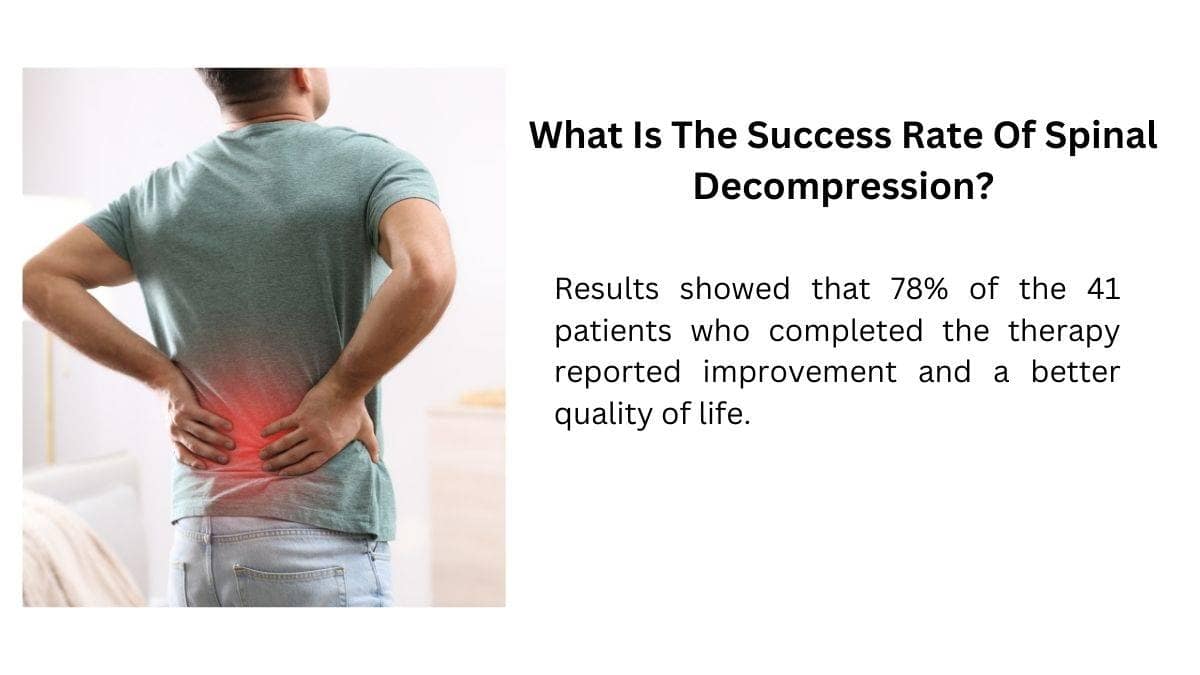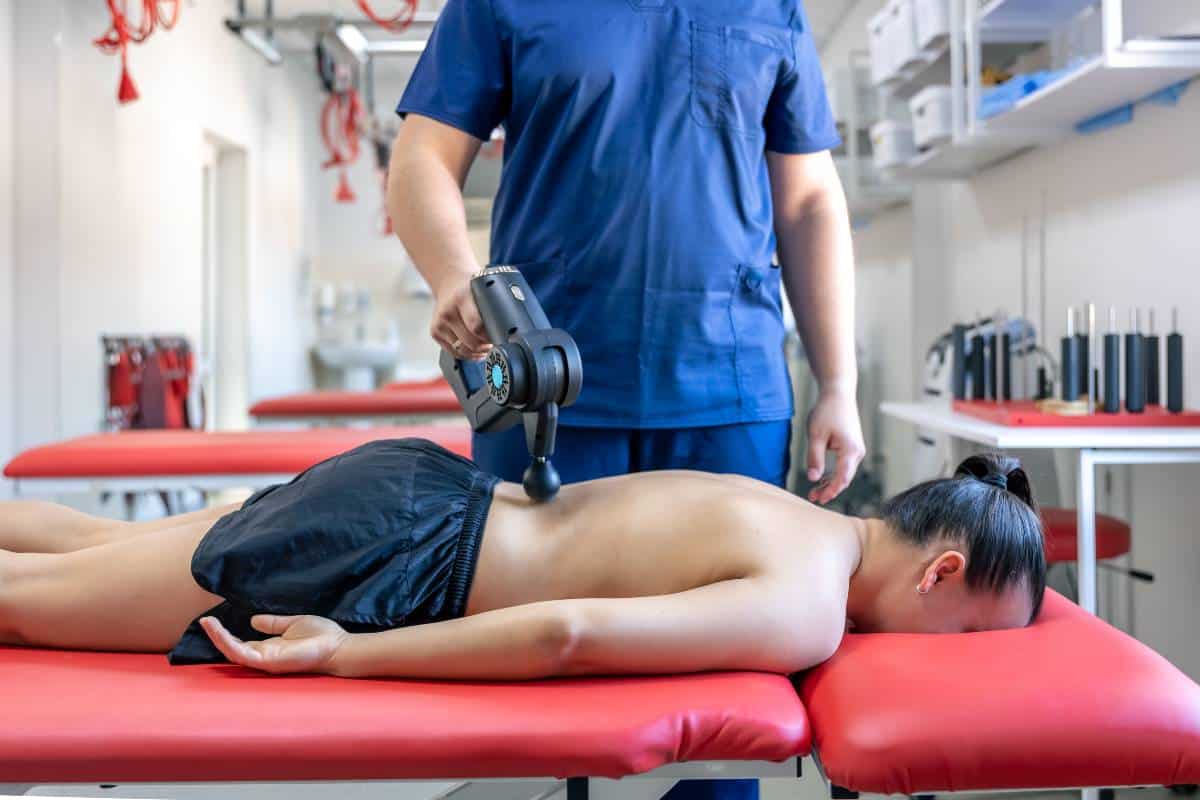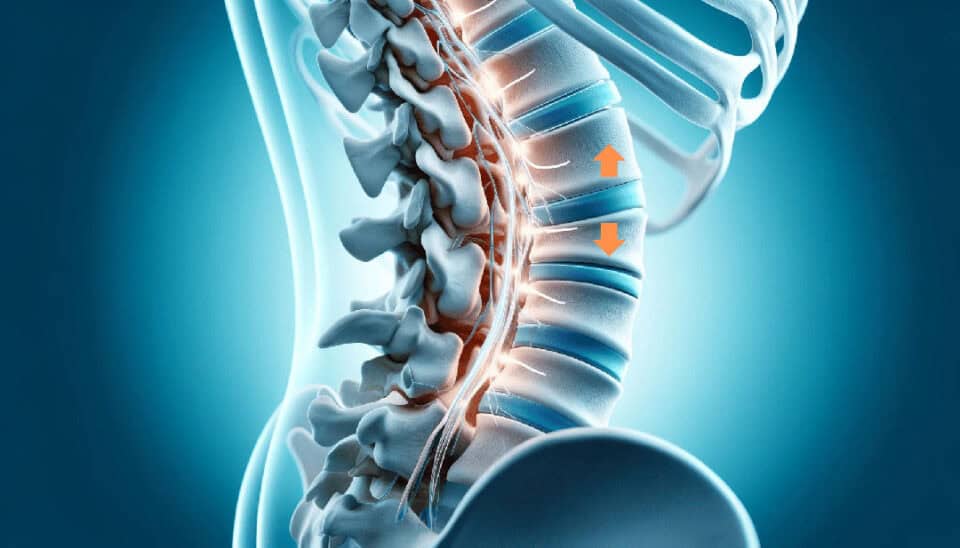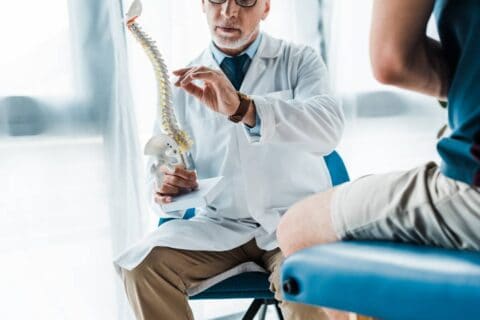Have you been struggling with chronic back pain, herniated discs, or sciatica? If so, you’re not alone. Millions of people worldwide experience these debilitating conditions, often feeling like there’s no hope for relief. However, I’m here to tell you about a groundbreaking treatment that has been helping patients achieve remarkable success rates: spinal decompression therapy.
As a chiropractor with years of experience in low back pain and neck pain, I’ve witnessed firsthand the incredible transformations that spinal decompression therapy can bring about. In this article, we’ll dive into the world of spinal decompression, exploring its effectiveness, the science behind it, and real-life success stories. By the end, you’ll have a clear understanding of why this therapy has become a beacon of hope for so many patients.
Key Takeaways
- Spinal decompression therapy is a highly effective, non-surgical treatment for chronic back pain and disc issues, with studies showing impressive success rates and long-lasting relief.
- Success factors include proper patient selection, condition severity, compliance, provider skill, and combining with other therapies.
- Spinal decompression offers a safe, cost-effective alternative to surgery for many patients, with faster recovery times. Consult a Spine Med specialist to determine if it’s right for you.
Understanding Spinal Decompression Therapy
So, what exactly is spinal decompression therapy? In simple terms, it’s a non-invasive treatment that gently stretches and decompresses the spine, creating a negative pressure within the discs. This negative pressure helps to:
- Retract herniated or bulging discs
- Promote the influx of healing nutrients and oxygen
- Reduce pressure on pinched nerves
- Alleviate pain and discomfort
Spinal decompression therapy is particularly effective for treating conditions such as:
- Herniated discs: When the soft inner material of a disc protrudes through a tear in the outer layer, causing pain and irritation.
- Bulging discs: When a disc bulges out of its normal space, putting pressure on nearby nerves.
- Degenerative disc disease: As we age, our lumbar discs can lose hydration and elasticity, leading to chronic low back pain and reduced mobility.
- Sciatica and pinched nerves: When a disc or bone spur puts pressure on the sciatic nerve, causing pain, numbness, or tingling sensations.
The treatment itself involves lying comfortably on a specialized decompression table, which applies precise and controlled traction to the spine. This gentle stretching helps to create space between the vertebrae, allowing the discs to return to their proper position and promoting healing.
One of the significant advantages of modern non-surgical spinal decompression technology1 is its ability to target specific areas of the spine, such as the lumbar region, with precision and control for patients treated. This means that patients can experience optimal results without undue stress on other parts of the body.
Is SpineMed Your Path to a Pain-Free Life?
Tired of living with back pain? Take our quick quiz to see if you’re a candidate for the breakthrough SpineMed Treatment. It only takes a few minutes to potentially change your life.
Research-Backed Success Rates
Now, let’s talk about the incredible success rates of the category of spinal decompression therapy. Numerous research studies2 have been conducted to evaluate its effectiveness, and the results are nothing short of impressive.
Study 1: Chronic Lower Back Pain
In a study published in the Journal of Back and Musculoskeletal Rehabilitation, researchers examined the effects of spinal decompression therapy on patients with chronic lower back pain. The study included 50 patients who had been experiencing pain for at least six weeks.
After receiving a series of spinal decompression treatments, an astonishing 88% of patients reported significant pain reduction, with many experiencing complete relief from symptoms like chronic low back pain and leg pain through non-surgical spinal decompression therapy. Furthermore, follow-up assessments showed that these results were maintained over time, indicating the long-term effectiveness of the therapy.
Study 2: Long-Term Pain Relief and Improved Function
Are you tired of living with chronic back pain and sciatica? Have you tried countless treatments without finding lasting relief? If so, you’re not alone. Millions of people struggle with these debilitating conditions every day. But what if I told you that there’s hope? There are non-invasive treatments out there that have been proven to provide long-term pain relief and even promote the healing of damaged discs.
Let’s take a look at some of the incredible research that’s been done in this field.
A study published3 in the Journal of Neuroimaging followed up with patients four years after they had received spinal decompression treatments. The results were mind-blowing. Over half of the patients reported a pain level of zero, and more than 90% were able to get back to their normal daily activities. And get this – four years later, more than 80% of them still had a 50% or greater reduction in pain.
That’s the kind of long-lasting relief that most people only dream of.
Study 2: Chiropractic Adjustments for Sciatica Relief
But it’s not just spinal decompression that’s showing promise.
Chiropractic adjustments have also been found to be incredibly effective at treating sciatica-related symptoms. The European Spine Journal revealed compelling results from a clinical trial4, demonstrating that chiropractic adjustments achieved a remarkable 72 percent success rate in alleviating sciatica-related symptoms. This success rate significantly surpasses that of physical therapy (20 percent) and corticosteroid injections (50 percent).
These findings underscore the effectiveness of chiropractic care in addressing sciatica and highlight its potential as a valuable treatment option. That’s huge in the realm of pain management for chronic lower back pain and neck pain without invasive procedures! And that’s just the chiropractic side. Imagine combining spinal decompression with chiropractic care! Now we are getting somewhere.
Study 3: MRI Evidence of Disc Improvement
And if you’re worried about the underlying causes of your back pain, like herniated or degenerated discs, there’s good news there too. Another study published in the Journal of Neuroimaging used MRI scans to look at the effects of spinal decompression therapy on these types of disc problems.
After just a few weeks of treatment, more than three-quarters of the patients showed a significant reduction in the size of their disc herniation. There was even evidence of increased disc hydration and improved disc height5, which suggests that the treatment was actually promoting the healing and regeneration of the damaged discs.
So if you’re feeling hopeless and frustrated with your chronic back pain or sciatica, don’t give up just yet. There are treatments out there that have been proven to work and work well. Spinal decompression and chiropractic adjustments are just two examples of the kind of non-invasive, drug-free options available for effective pain management and treatment of conditions like chronic low back pain, leg pain, and neck pain.
And with success rates like the ones we’ve seen in these studies, it’s definitely worth giving them a try. Why is it working? Because we are actually healing the true cause of your symptoms rather than just masking symptoms with medications. It’s not rocket science.
Factors Influencing Success Rates
While spinal decompression therapy has shown remarkable success rates, it’s essential to understand that various factors can influence individual outcomes. Let’s explore some of these factors and how they can impact the effectiveness of treatment.
Patient Selection and Candidacy
One of the most crucial factors in determining the success of spinal decompression therapy is proper patient selection. While this treatment can be highly effective for many individuals, not everyone is an ideal candidate.
Patients who are most likely to benefit from non-surgical spinal decompression therapy typically have chronic low back pain, lumbar disc issues, or spinal stenosis, with many experiencing complete relief.
- Herniated or bulging discs confirmed by MRI
- Chronic back pain lasting more than six weeks
- Failed conservative treatments, such as physical therapy or traditional chiropractic adjusting
On the other hand, certain conditions may preclude patients from undergoing spinal decompression therapy, such as:
- Spinal fractures
- Spinal tumors
- Severe osteoporosis
- Pregnancy
- Stage 2 and above: Spondylolisthesis
- Severe Scoliosis
At The BodyFix we would carefully evaluate each patient’s medical history, symptoms, and diagnostic imaging to determine their suitability for spinal decompression therapy.
Severity and Duration of the Condition
The severity and duration of a patient’s condition can also impact the success of spinal decompression therapy. Generally, patients with more recent onset of symptoms and less severe disc damage tend to respond more quickly and favorably to treatment.
However, this doesn’t mean that patients with long-standing or severe conditions cannot benefit from spinal decompression therapy. In many cases, a customized treatment plan and a commitment to the full course of therapy can still yield significant improvements especially when we incorporate a rehabilitation exercise protocol for the anatomical part in question.
Compliance with Treatment Protocol
Patient compliance is another key factor in achieving optimal results with spinal decompression therapy. This means attending all scheduled treatment sessions, following the healthcare provider’s recommendations for home care, and making necessary lifestyle modifications.
Patients who are dedicated to their treatment plan and actively engage in their own recovery process often experience the most significant and lasting improvements. It’s not just a quick fix, it’s a lifestyle change!
Combination with Other Therapies
While spinal decompression therapy can be highly effective on its own, combining it with other complementary therapies can often enhance its benefits. These may include:
- Chiropractic adjustments
- Rehab exercises
- Soft tissue mobilization or myofascial techniques
- Lifestyle modifications, such as improving posture and ergonomics
- Nutritional Supplementation
We would develop a comprehensive treatment plan that incorporates the most appropriate therapies for each individual patient, maximizing their potential for success.
Expertise and Experience of Healthcare Providers
Finally, the expertise and experience of the healthcare provider administering spinal decompression therapy can significantly impact patient outcomes. It’s essential to choose a provider who has received proper training, has the most modern technological machine, has a track record of success, and stays up-to-date with the latest advancements in the field.

Recent reviews of popular medical literature suggest that Spinal Decompression Therapy has shown promising results in managing pain and improving the quality of life for a significant number of patients. According to these reviews6, over 75% of individuals who underwent this treatment experienced effective pain relief and long-term benefits upon completing the full course of therapy.
In a study conducted by Santa Corona Hospital in Italy, researchers investigated the efficacy of non-surgical decompression. The results of this study indicated that among the 41 patients who completed the therapy, 78% reported improvements in their condition and a notable enhancement in their overall quality of life.
Furthermore, various reports have highlighted the success rate of Spinal Decompression Therapy, with figures ranging from 71% to 89%, depending on the machine used. These findings underscore the potential of this treatment approach in addressing spinal issues and providing patients with a non-invasive alternative to surgical interventions.
While these studies and reports offer encouraging insights into the effectiveness of Spinal Decompression Therapy, it is essential to note that individual patient outcomes may vary depending on factors such as the severity of the condition, overall health, and adherence to the prescribed treatment plan. As with any medical treatment, it is advisable to consult with a qualified healthcare professional to determine the most appropriate course of action for each patient’s specific needs.
Spinal Decompression vs. Other Treatments
When it comes to treating chronic back pain and disc-related issues, patients often find themselves weighing the options between spinal decompression therapy and other treatments, such as surgery or conservative approaches. Let’s compare the success rates and advantages of spinal decompression therapy to these alternatives.
Comparison of Spinal Decompression Success Rates with Surgery
Spinal surgery, such as a discectomy or fusion, is often considered a last resort for patients with severe disc damage or when conservative treatments have failed. While surgery can be effective in certain cases of lumbar or neck issues, it also comes with significant risks, including infection, nerve damage, and long recovery times.
In contrast, spinal decompression therapy offers a non-invasive alternative with a much lower risk profile. Research has shown that the success rates of spinal decompression therapy are comparable to those of surgery, with some studies indicating a success rate of up to 89% for patients with herniated discs.
Furthermore, spinal decompression therapy allows patients to avoid the lengthy recovery period associated with surgery, enabling them to return to their normal activities more quickly.
Comparison of Success Rates with Conservative Treatments
Conservative treatments, such as chiropractic care and physical therapy, can be effective for managing chronic back pain and promoting overall spinal health. However, these approaches may have limitations when it comes to addressing specific disc-related issues.
Spinal decompression therapy, on the other hand, is designed to target herniated, bulging, and degenerated discs directly. By creating negative pressure within the discs, this therapy can help to retract protruding disc material, reduce pressure on nerves, and promote healing.
Studies7 have shown that spinal decompression therapy can produce superior results compared to conservative treatments alone, particularly for patients with disc-related conditions.
Advantages of Spinal Decompression Therapy
In addition to its high success rates, non-surgical spinal decompression therapy offers several key advantages over other treatment options for managing chronic low back pain.
- Non-invasive nature: Spinal decompression therapy is a non-surgical, drug-free approach that avoids the risks and complications associated with invasive procedures.
- Lower risk of complications: Compared to surgery, non-surgical spinal decompression therapy carries a significantly lower risk of complications, such as infection, nerve damage, or adverse reactions to anesthesia, especially in patients with chronic low back pain or spinal stenosis.
- Faster recovery time: Patients undergoing spinal decompression therapy can typically return to their normal activities more quickly than those recovering from surgery, as there is no need for extensive healing of incisions or scar tissue.
Cost-Effectiveness of Spinal Decompression Therapy
In addition to its clinical advantages, spinal decompression therapy can also be a more cost-effective option compared to surgery. The costs associated with surgical procedures, including hospital stays, anesthesia, and post-operative care, can be substantial.
Spinal decompression therapy, in contrast, is typically performed on an outpatient basis, requiring no hospitalization or extended recovery periods. This can result in significant cost savings for patients while still providing effective relief from chronic back pain and disc-related issues.
Candidacy for Spinal Decompression Therapy
While spinal decompression therapy can be highly effective for many patients, it’s important to understand that not everyone is an ideal candidate for this treatment. A skilled healthcare provider will carefully evaluate each patient’s unique situation, including pain scores and the presence of conditions like lumbar disc degeneration, to determine whether non-surgical spinal decompression therapy is appropriate.
Ideal Candidates for Spinal Decompression Therapy
Patients who are most likely to benefit from non-surgical spinal decompression therapy typically have chronic low back pain, lumbar disc issues, or spinal stenosis, with many experiencing complete relief.
- Herniated or bulging discs confirmed by MRI
- Chronic back pain lasting more than six weeks
- Failed conservative treatments, such as physical therapy or chiropractic care
- No contraindications, such as spinal fractures or tumors
Contraindications and Precautions
Certain conditions may preclude patients from undergoing spinal decompression therapy, or require special precautions. These include the management of chronic low back pain, leg pain, and spinal stenosis through non-surgical means.
- Spinal fractures
- Spinal tumors
- Severe osteoporosis
- Pregnancy
- Certain surgical implants or hardware
Importance of Proper Patient Selection for Optimal Results
Proper patient selection is crucial for achieving the best possible outcomes with spinal decompression therapy. By carefully evaluating each patient’s medical history, symptoms, and diagnostic imaging, healthcare providers can ensure that the treatment is applied to those who are most likely to benefit.
This not only maximizes the potential for success but also helps to avoid unnecessary treatments for patients who may be better served by alternative approaches.
Patient Testimonials and Case Studies
While research studies provide compelling evidence for the effectiveness of spinal decompression therapy, sometimes the most powerful testament to its success comes from the real-life experiences of patients who have undergone treatment.
Let’s take a look at a couple of patient testimonials.
Becca Bessinger’s Story
Becca Bessinger, a long-time chiropractic patient, had this to say about her experience with Dr. Mario Tolj and spinal decompression therapy:
“I’ve been seeing Dr. Mario for over a year now, and I continue to be amazed by his knowledge and skill. He truly cares about the health and well-being of his patients and is continually educating himself on the most recent research of body mechanics and holistic approaches to spinal stability. I have benefitted immensely from his hands-on work and the exercises that he has tailored for my specific issues. Wow. I’ve been seeing chiropractors for about 30 years and have never encountered one like Dr. Mario! He is one-of-a-kind, and I highly recommend him!”
Christopher Cox’s Journey
Christopher Cox, a patient who had suffered a lower back injury at work, shared his experience with spinal decompression therapy under Dr. Tolj’s care:
“After about 8 visits, I am virtually pain-free. I highly recommend Dr. Mario at the Body Fix to anyone in need of chiropractic care.”
Christopher’s story emphasizes the gradual, yet significant improvement that patients can experience with spinal decompression therapy, even after just a few sessions.
These testimonials provide a glimpse into the profound impact that spinal decompression therapy can have on patients’ lives, helping them to overcome chronic pain and regain their quality of life.

Preparing for Spinal Decompression Therapy
If you’re considering spinal decompression therapy, it’s essential to understand what to expect and how to prepare for your treatment.
Here’s a brief overview of the process:
Initial Consultation and Evaluation
Your first step will be to schedule an initial consultation who specializes in non-surgical spinal decompression therapy for chronic low back pain. During this visit, Dr. Mario will:
- Review your medical history and current symptoms
- Perform a physical examination
- Discuss your treatment goals and expectations
This consultation is an opportunity for you to ask questions, learn more about the therapy, and determine whether it’s the right choice for your specific needs.
Diagnostic Imaging and Testing
In most cases, Dr. Mario will order diagnostic imaging based on examination findings, such as an MRI, to better understand the underlying cause of your back pain or disc-related issues. This imaging will help to guide your treatment plan and ensure that spinal decompression therapy is applied effectively.
Additional testing, such as neurological exams or range of motion assessments, may also be performed to gather a comprehensive picture of your spinal health.
Customized Treatment Planning
Based on the findings of your initial consultation and diagnostic testing, Dr. Mario will develop a customized treatment plan tailored to your unique needs. This plan will outline the frequency and duration of your spinal decompression therapy sessions, as well as any complementary therapies or lifestyle modifications that may be recommended.
By understanding the preparation process and working closely with him, you can ensure that you’re well-positioned to achieve the best possible results from spinal decompression therapy.
Is SpineMed Your Path to a Pain-Free Life?
Tired of living with back pain? Take our quick quiz to see if you’re a candidate for the breakthrough SpineMed Treatment. It only takes a few minutes to potentially change your life.
FAQs
How long does spinal decompression therapy take to show results?
Is spinal decompression therapy painful?
Are the results of spinal decompression therapy permanent?
Can spinal decompression therapy be used after failed back surgery?
Are there any side effects of spinal decompression therapy?
Conclusion
If you’re struggling with chronic back pain, herniated discs, or other spinal issues, I want you to know that there is hope. Spinal decompression therapy has helped countless patients find relief and reclaim their quality of life, and it could be the solution you’ve been searching for.
I understand how frustrating and debilitating conditions like chronic low back pain and spinal stenosis can be because I have them myself, and I’m here to help through non-surgical spinal decompression therapy. With my extensive experience and commitment to patient care, I’ll work with you to develop a personalized treatment plan that addresses your unique needs and goals.
Don’t let back pain control your life any longer. Take the first step towards recovery by scheduling a consultation with me, Dr. Mario Tolj. Together, we can explore the remarkable potential of spinal decompression therapy and create a path forward to a healthier, happier you. You deserve to live pain-free, and I’m here to help you achieve that. Schedule a consultation with me today!
- https://www.ncbi.nlm.nih.gov/pmc/articles/PMC1887522/ ↩︎
- http://temeculadisccenter.com/research.php ↩︎
- http://www.avoidbacksurgerynj.com/research.php ↩︎
- https://www.btetechnologies.com/therapyspark/sciatica-treatment-with-manual-techniques-stretches-and-exercises-the-chiropractic-perspective/ ↩︎
- https://www.ncbi.nlm.nih.gov/pmc/articles/PMC5481589/ ↩︎
- https://www.ncbi.nlm.nih.gov/pmc/articles/PMC1887522/ ↩︎
- https://www.ncbi.nlm.nih.gov/pmc/articles/PMC8924735/ ↩︎
Blog Disclaimer: The information provided on The BodyFix Chiro blog is for general informational and educational purposes only and is not intended as medical advice. These articles reflect our opinions and experiences but should not be used to diagnose or treat any health conditions. Always consult with your physician, chiropractor, or other qualified healthcare provider before starting any new treatment, exercise program, or making changes to your health routine. Any actions you take based on information from this blog are entirely at your own risk, and The BodyFix Chiro and its contributors disclaim any liability for the decisions you make based on this information.




